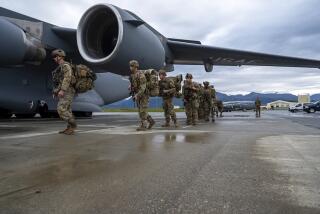Elite U.S. fighters get tested in new climes
- Share via
HICKAM AIR FORCE BASE, HAWAII — The Air Force this summer has been breaking in its new fleet of F-22s, regarded to be the world’s most advanced fighter jet, by sending five of the planes from cool and dry Alaska to hot and humid Guam.
The F-22 Raptors, which the Air Force says have unrivaled ability to fly at supersonic speeds for long periods and travel undetected by radar, have been operational for less than three years.
Elmendorf Air Force Base in Alaska has been home to two F-22 squadrons since last year. It is only the second base to house the stealth fighters, after Langley Air Force Base in Virginia.
The July 18-Aug. 2 deployment of five Raptors from the Elmendorf’s 90th Fighter Squadron to the U.S. territory marked just the second time the F-22 has ventured outside the 50 states. Its first such trip was early last year, when Pacific Air Forces sent 12 Langley-based F-22s to Okinawa in southern Japan for three months.
The Guam deployment offered the Elmendorf crews a chance to grow accustomed to flying and maintaining the F-22 in Guam’s climate.
It also signaled to countries in the region how important the Asian-Pacific area is to U.S. security interests, military officials said.
Guam, about 3,000 miles west of Hawaii, sits near key U.S. allies Japan and South Korea.
It also lies close to North Korea, whose autocratic regime has been at odds with the U.S. over that nation’s nuclear weapons program. Taiwan, the self-governing island China considers a renegade province, is another regional concern for the U.S. military.
Washington officially has a one-China policy that opposes Taiwanese independence or a referendum on United Nations membership for the island. But the U.S. is also committed to defending Taiwan from any attack by China.
“Guam is a very strategic location,” said Maj. Lance Hobson, the 13th Air Force chief of fighter operations. “There’s always potential for instability in the region. By exercising our forward presence in a place like Guam, it gives us better capability and demonstrates our dedication to the region.”
Normally the Air Force would send more than five fighter jets on a deployment. It limited the number this time, however, because the squadron is still getting used to the F-22, officials said.
While on Guam, the Raptors practiced defending the island in the event of an attack.
The exercise involved dropping 20 live bombs on Farallon de Medinilla, a military target range in the nearby U.S. Commonwealth of the Northern Mariana Islands.
The planes also practiced in concert with F-15s and B-52s.
Staff Sgt. Luke Vetter, the 90th Maintenance Squadron’s weapons crew chief, said his team expected weapon systems equipment to break down in Guam’s humidity and that the island’s salty air would disrupt the electronics.
But neither turned out to be the case. Even so, the weapons crew had other environmental differences to adjust to, such as 100-degree temperatures.
“The worst part, I think, was the unexpected rain when we’re trying to work,” Vetter said.
The Air Force says it will probably send F-22s back to Guam, where the service also rotates F-15s and F-16s from the U.S. mainland.
“You use your best weapons to defend your most important interests,” said Loren Thompson, a defense analyst with the Lexington Institute in Arlington, Va. “Sending the F-22s to Guam definitely signals resolve to countries like China and North Korea. It’s the best fighter in the world, so it probably has a deterring effect on any aggressive impulses.”
The military plans to buy 183 F-22s, which each cost about $160 million. The Air Force plans to base three of the seven proposed squadrons in the Pacific.
In addition to the two in Alaska, one squadron will be based at Hickam Air Force Base with the Hawaii Air National Guard. Two other squadrons will be based at Holloman Air Force Base in New Mexico.
More to Read
Sign up for Essential California
The most important California stories and recommendations in your inbox every morning.
You may occasionally receive promotional content from the Los Angeles Times.













